Painting suggests a real or imaginary world through the use of colored strokes. In art, creativity is essential. Artists express it by employing unique techniques that give their works a distinct identity on a canvas. The canvas consists of a support, a fine layer of sizing, the ground, the medium or pictorial layer, and a varnish.
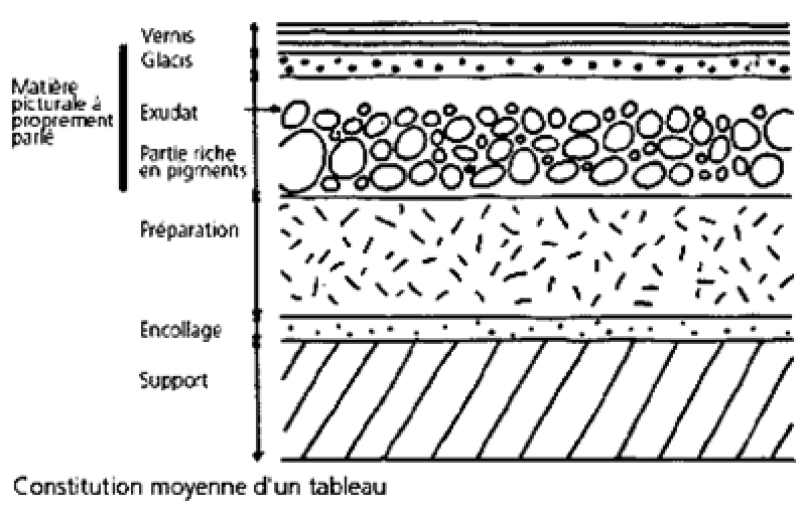
Diagram of the different layers of a panel.
If painting were to be divided into different categories, they could mainly be grouped according to their composition. There are techniques based on water, oil, or binders such as egg yolk or wax.
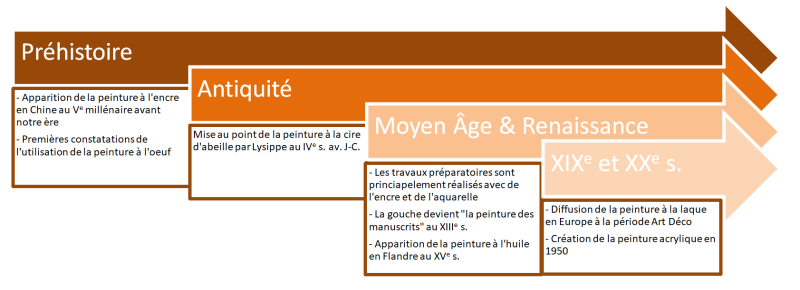
Tempera painting
Tempera is a technique that involves mixing pigments with egg yolk. It has been used since prehistoric times and reached its peak during the Renaissance. It can be applied to thick paper, plaster, or canvas to ensure proper adhesion. For a more refined finish, several thin layers must be added and transparency manipulated. Some painters also add titanium white pigment or play with the gesso undercoat. It is a fast-drying technique.
Unvarnished tempera does not darken over time, unlike oil paint. Light values therefore remain more luminous. However, dark colors are not as deep as those achieved with oil. When varnished, tempera can achieve similar depth. To enhance the shine, tempera is polished with a cloth, whereas traditional varnish alters the color appearance (saturation, matte, satin or gloss finish) and yellows over time. Tempera can also be burnished using an agate stone.
Tempera becomes brittle and fragile over time, so it is recommended for use on rigid supports.
Wax painting
Encaustic painting, or painting with beeswax, is also one of the oldest known painting techniques. According to Pliny the Elder, the painter Lysippus developed the process in the 4th century BCE using a heated metal plate to which beeswax and pigments were applied before painting on a wooden support. Its exceptional resistance to humidity has preserved artworks over 2,000 years old, such as the Fayum portraits. This resistance can be further enhanced by adding dammar (a resin used for varnishes and mediums), which also adds gloss. Unlike other mediums, wax painting does not require drying time as it hardens instantly on the support, and it can be reworked indefinitely by reheating.
Although this technique fell out of favor with the advent of oil painting, it was revived in the 20th century by prominent artists such as Jasper Johns and Simon Hantaï.
Ink painting
Ink painting is a technique commonly used in Sino-Japanese art since the 5th millennium BCE, later appearing in the West. It is typically diluted with water and produces effects similar to watercolor. Works are often created on thick paper, allowing the ink to fully penetrate and create washes. For centuries, it was primarily used for preparatory work before becoming a recognized technique in its own right.
There are several types of inks used in painting:
- Carbon black inks made from candle soot or oil lamp soot, which are water-soluble (except for Chinese ink). These are mainly used for washes.
- Iron gall inks made from plant tannins like gallnuts and metal salts, which tend to darken over time. Artists prefer them for pen drawings.
- Bistre, derived from burning wood, offers a wider range from yellow-brown to dark brown. It is also used for colored washes and paper tinting.
- Sepia, extracted from cuttlefish, has a purplish tone. This ink appeared in the 17th century and reached peak popularity in the 19th century.
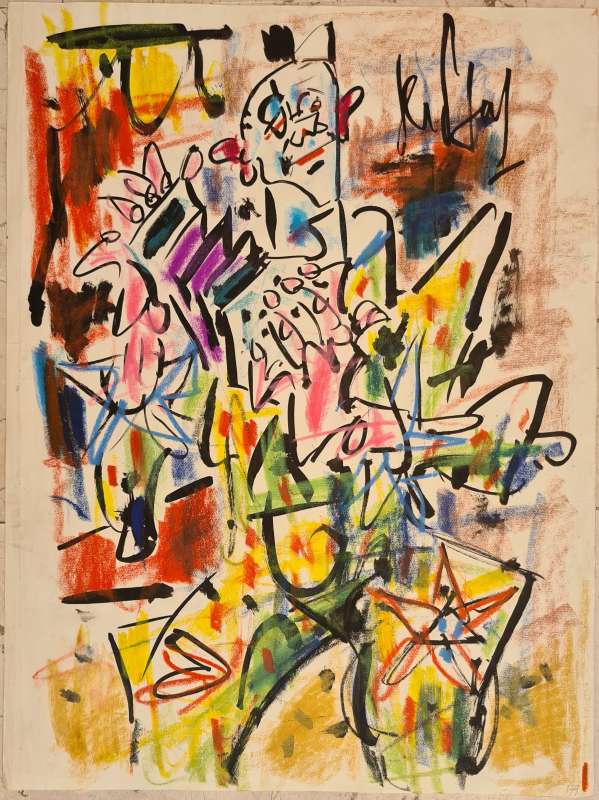
Gen Paul uses ink to highlight the energy of his gesture.
Watercolor painting
Watercolor is a painting technique that emerged in the 15th century on parchment and paper. It became popular in the modern era as a standalone art form rather than a preparatory study. Tools can take the form of pencils, chalks, or liquid watercolors to be mixed with water. Watercolor is practiced on thick supports or silk to absorb the water properly. It allows for quick creation, but requires great precision and mastery of transparency.
Gouache painting
Gouache, or “guazzo” in Italian, is also a water-based paint. However, it is more opaque and covering than watercolor or acrylic, making it effective for layering tones. The color is thickened with chalk. The binder is often gum water (a mix of distilled water and gum arabic). Gouache is highly practical, as it can be diluted to resemble watercolor in texture.
Gouache has many strengths. It is easy to use with water, quite opaque, and the colors are vibrant. This method facilitates mixing and accelerates drying. Like oil paint, it can be applied in thick layers without water, drying much faster—but impasto applications may flake. It can also be heavily diluted to produce watercolor-like washes and transparencies. However, gouache must be framed under glass and should not be varnished, as varnish can unpredictably alter its colors.
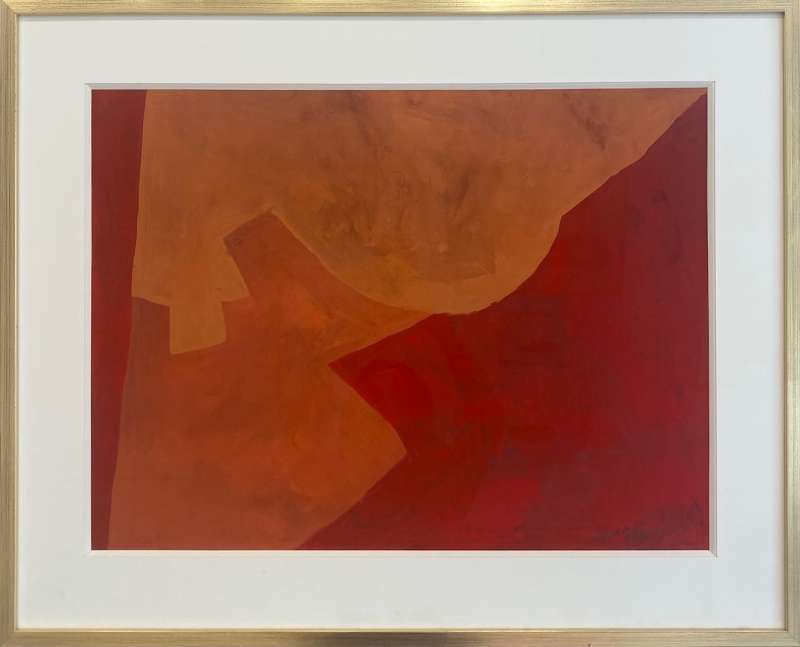
Serge Poliakoff particularly appreciated gouache painting, which allowed him to explore the subtlety of layered tones.
Oil painting
Oil painting was developed by Flemish painters in the 15th century. As the name suggests, this method consists of mixing color pigments with oil (linseed, poppy, walnut, etc.). Each oil provides specific qualities. For example, pigments mixed with linseed oil diluted in turpentine enable slow drying and allow for numerous glazes and reworkings. It is often done on canvas stretched over a frame. Oil painting is particular in that it dries slowly (1 to 3 weeks). It offers brilliance and luminosity, and is more durable than other mediums—canvases can be rolled without damaging the paint layer. However, varnishing is essential to preserve colors and prevent cracking during drying.
To ensure optimal adhesion to the surface and prevent cracks, a specific process called “fat over lean” must be followed—layering increasingly oily mixtures. Proper surface preparation is essential: first isolate it with glue, then apply a primer to prevent the oil from being absorbed. Oil paint allows for relief and texture effects thanks to its thick consistency, adding depth and dynamism to the artwork.
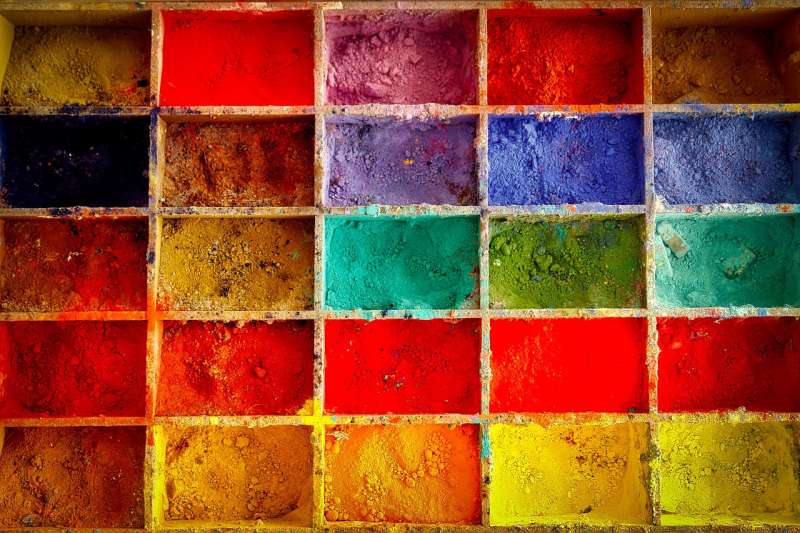
Acrylic painting
Acrylic is a painting technique introduced in the 20th century. It involves mixing pigments with synthetic resins diluted in water. Acrylic has a glossy appearance and adheres well to the support. It also dries quickly.
Acrylic has a slightly thicker texture than gouache and a shinier finish. It enables clean cuts and sharp outlines, and can also be used to create texture. Due to its quick drying, gradients and blending are harder to achieve.
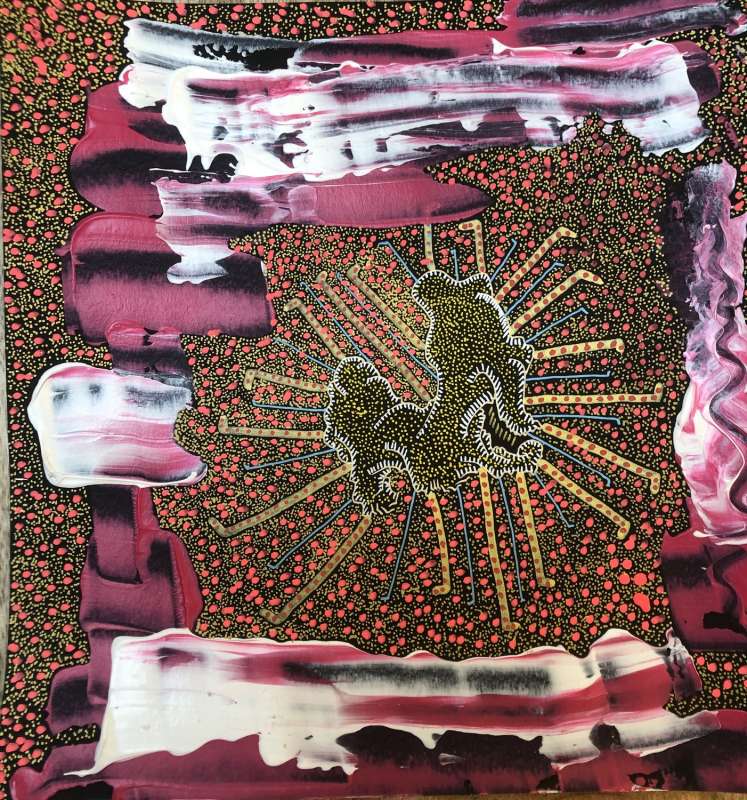
The density of acrylic paint allows Gréké to create thick textures that contrast perfectly with the fineness of his patterns.
Lacquer painting
Lacquer painting originated in Vietnam in the 20th century before developing in the West during the Art Deco period.
It is a technique that mixes pigments—sometimes with precious materials like gold or silver—to create a constant and unpredictable play of light. Preparing the sap is a lengthy process, but high-quality lacquers can last for centuries or even millennia without deterioration. Typically applied to wooden supports, lacquer is built up layer by layer, with each layer being polished. French artists rarely use lacquer painting due to its complexity and time demands, but the boldest, such as Dunand, have embraced it.
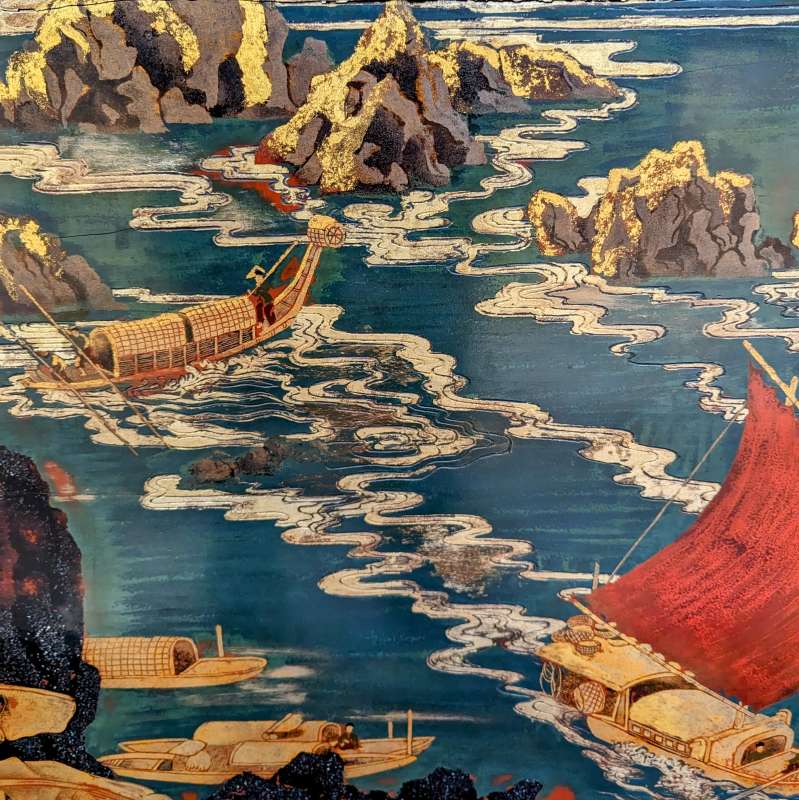
Phạm Hậu, The Rapids of Cho-Bo, Lacquer, with highlights of gold, silver, and crushed mother-of-pearl (detail)
This is the final layer, composed of a resin diluted in a solvent, covering the painting to protect it—although oil painting varnishes tend to darken over time. Some varnishes serve a dual purpose: both aesthetic and preservative. Varnish is a hard, transparent layer that can be glossy or matte and may degrade depending on the resin used. The glossiness of a varnish comes from its resin: the smoother the varnish, the shinier it appears. It enhances colors, increases brilliance, and unifies the painting in addition to the glaze.
There are two types of varnish: oil-based (fat) and spirit-based (lean). The former is diluted with oil, making it more glossy and resistant to humidity, but it tends to yellow over time. Lean varnishes, often using turpentine, are transparent and less prone to yellowing, though they are more sensitive to moisture. Contemporary varnishes are made of synthetic resins in a solvent, which makes them similar to lean varnishes. They tend to reflect a bluish hue and appear less smooth than natural resins as they age.
When varnish becomes damaged or yellowed, the preservation of the artwork is compromised and restoration becomes necessary.
Did you know? Painters used to varnish their works just before exhibiting them in salons, allowing select wealthy guests a preview. This event preceding the public unveiling naturally came to be called a “vernissage.”
A painting can be executed on a range of surfaces that greatly affect the texture, appearance, and durability of the artwork. Each support offers advantages and disadvantages depending on the artist's technique and objectives. Artists can explore a broader range of expressions and styles thanks to their specific characteristics, thereby enriching their creative practice. However, they also come with specific constraints, especially hygroscopic supports (i.e., those that absorb and release water vapor), which means they expand and contract with changes in relative humidity. This can cause cracks in wooden supports, warping in paper-based supports, and stretching or wrinkling in canvas supports.
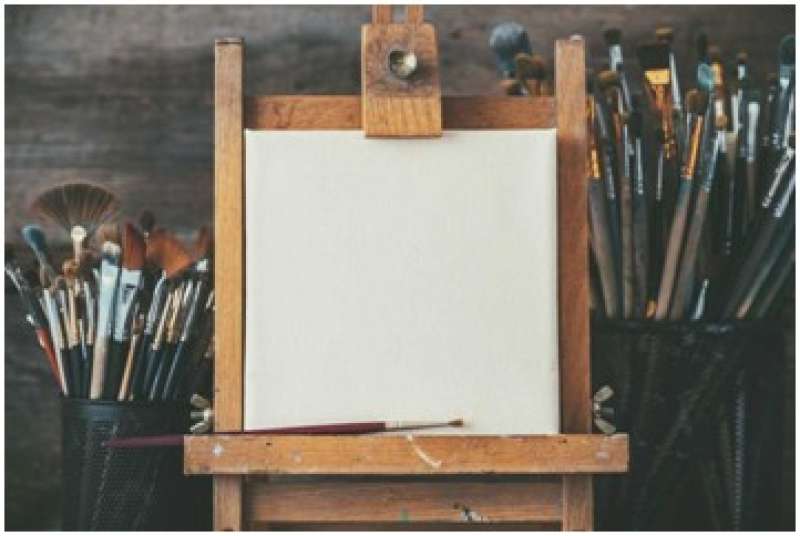
CANVAS
Canvas has been used since Antiquity but fell out of favor during the Middle Ages due to supply difficulties, until the invention of weaving machines in the 15th century. Venetians were the first to use this technique on organ shutters in Venice, before it spread throughout Italy in the 16th century and then to Flanders thanks to Rubens. It later became the preferred support for paintings up to recent times. However, canvas is sensitive to shocks and tears, so it must be mounted on a rigid support (marouflage) or stretched on a frame.
Linen: Highly prized for its strength and fine texture, linen canvas is one of the most traditional supports. It is highly resistant to distortion and moisture, making it ideal for long-lasting works. It is also one of the most expensive types of canvas.
Cotton: More affordable than linen, cotton is also widely used. It is less durable but offers a smooth surface suitable for various types of painting. It is also more flexible, making it easier to stretch and handle depending on humidity levels.
Hemp: Hemp canvas is a durable and resistant support, valued for its rough and natural texture, which gives depth to artworks. Its intermediate absorbency allows for rich and vibrant colors, while its dimensional stability ensures good long-term preservation. Versatile, it is suitable for various painting techniques, especially oil and acrylic. However, hemp canvas is rarely used nowadays.
Jute: Jute canvas is a low-cost, highly textured support offering a coarse surface that can add tactile dimension to artworks. Its thick and rough fibers require careful preparation with gesso to avoid excessive paint absorption. Although less durable than linen or cotton—even when stretched—it is often used for experimental works or large-scale pieces due to its low cost and availability.
Synthetics (polyester): Synthetic canvases, mainly made from polyester or nylon, are valued for their strength and durability. They offer excellent stability, showing no deformation over time or with changes in humidity and temperature. Their smooth and uniform surface allows for even paint application and fine detail. Less absorbent than natural canvases, they require less preparation, reducing the need for gesso and priming layers, though paint adhesion can still be a challenge. Their cost is generally lower than linen or cotton canvases. Additionally, they are suitable for various painting techniques, including acrylic and oil, offering artists great flexibility.
SILK
Silk is appreciated for its soft and refined texture, offering a smooth surface that allows for very fine and delicate detail. Its ability to hold vivid and luminous colors makes it an ideal choice for works requiring bright and vibrant tones. Silk is light and flexible, making it easy to stretch or mount. However, it is also fragile and requires special care to prevent tears and moisture damage. As a natural material, silk lends a unique elegance to artworks but demands careful preparation to ensure good pigment adhesion.
PAPER
Paper was invented in China during the Zhou dynasty around the 6th century BCE using hemp fibers and tree bark. Its production spread through Asia and Europe via the Silk Roads.
It is a widely used support due to its accessibility and the multitude of textures and weights available. Its absorbent surface is ideal for watercolor, allowing for smooth washes and subtle color blending. Heavier and more textured papers are perfect for pastel and gouache, providing good pigment adherence. Smooth paper is preferred for precise drawings and fine detail, such as ink work. However, paper can be vulnerable to humidity and light, requiring precautions for artwork conservation. Overall, paper is a versatile and essential support for many artists, enabling a wide variety of styles and techniques.
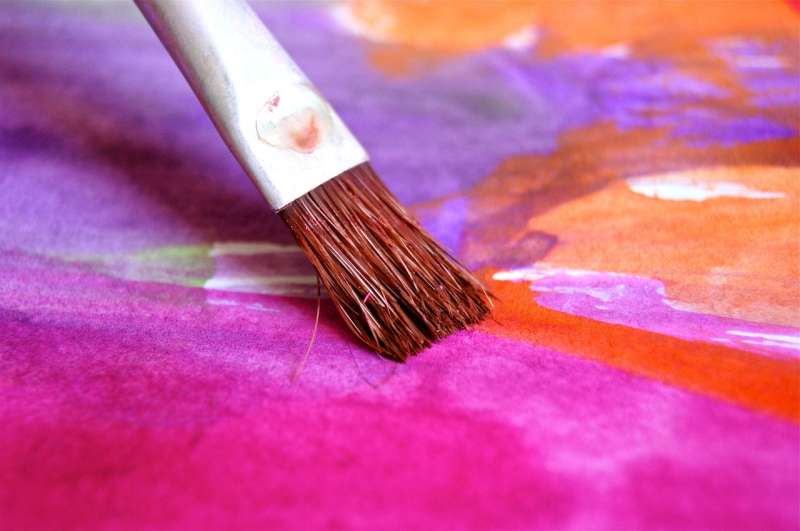
WOOD
Wood has been used as a painting support since Prehistoric times and saw a boom during Antiquity. The word "tableau" comes from the Latin tabula (board, wooden plank). Wood stands out for its sturdiness and durability, offering a rigid surface depending on its species and grain. It allows for smooth and detailed paint application, especially valued in oil and acrylic painting. Wood can be primed with gesso to seal the surface and prevent excessive absorption of paint, ensuring good pigment adhesion. However, it can warp or crack due to humidity, requiring proper care to keep the artwork intact and prevent mold growth.
GLASS
Thanks to its smooth and non-porous surface, glass offers remarkable luminous and translucent effects. It is particularly used in specific techniques such as reverse glass painting and stained glass, where the transparency of the material can be used to create spectacular light effects. Reverse glass painting requires special paints that adhere well to the surface; otherwise, ox gall must be applied before adding paint layers. Though fragile and breakable, glass is moisture-resistant and ensures good artwork preservation. It adds elegance and clarity to artistic creations, making each piece unique through its ability to play with light and color.
A painting’s support is generally twofold: first, there is the painted surface itself, and second, an auxiliary support that reinforces the artwork. Paintings made on thin, rigid materials can be mounted or adhered to an auxiliary support to strengthen them so they can be handled or framed.
The most commonly used support is the wooden stretcher. The stretcher, made of a set of bars designed to fit the canvas, ensures its tension and stability, providing an even surface for painting. It plays a crucial role in preparing the artwork, ensuring both its durability and proper presentation.
Stretchers vary in size and shape, with some reinforced by crossbars for large-scale works. They are easy to adjust and allow artists to create paintings in various sizes while keeping the canvas properly stretched.
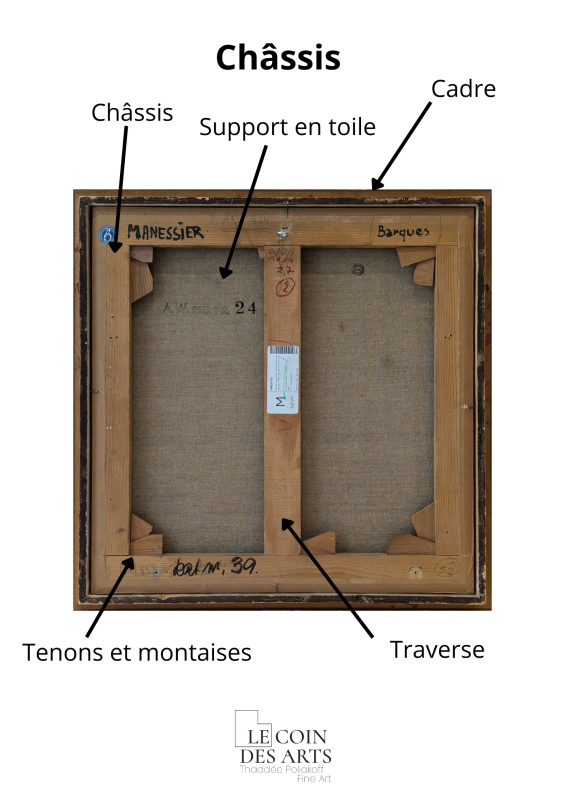
The wooden frame, also known as the "stretcher," forms the main structure on which the canvas is mounted. Tenons and mortises—wooden joints—are essential components of the stretcher: the mortise is an opening into which the tenon fits to securely assemble the different parts of the frame. To fix these joints, small nails called tacks are used to ensure the solidity of the whole. Finally, wooden crossbars are additional pieces inserted into the frame to re-tighten the canvas and provide extra support, which is particularly helpful for large works. These elements ensure that the canvas remains taut and stable, offering a uniform surface for painting and contributing to the artwork’s durability and proper presentation.
There are also keyed stretchers, which feature an adjustable tensioning mechanism. This type of stretcher has corners assembled with keys—small wooden wedges inserted into mortises at the frame’s corners. By inserting or removing these keys, it is possible to adjust the canvas tension over time.
Ground (Primer): A ground is a neutral layer of material applied to a painting surface to make it less absorbent and to prevent it from altering the appearance and consistency of the paint. A canvas is said to be "primed" when a protective, resistant coating isolates the fabric from the medium.
Monochrome (Camaïeu): This term refers to a technique that plays with different shades of a single color or closely related colors. It helps create effects of depth, volume, and texture by using tonal and intensity variations rather than a wide color palette.
Sizing: Sizing involves applying glue, generally animal-based, to seal the pores of wood or the weave of canvas. It isolates the cellulose fibers from oil and helps stabilize and waterproof the support.
Ground Coat: The ground coat is a preparation layer made from gesso, rabbit skin glue, or plaster to prepare the painting surface.
Technique (Facture): In art, "facture" refers to the way an artwork is made, emphasizing the techniques, materials, and gestures used by the artist. It includes visible aspects of the creative process such as brushstrokes, textures, and finishes, as well as technical choices that influence the final appearance.
Gesso: A ground made of plaster or gypsum mixed with animal glue, used since ancient Egypt to paint wooden ushabtis. It was polished during the Renaissance to enhance the pictorial effect.
Glaze: Artists often used transparent colored layers, known as glazes, to build up colors and create effects of depth, light, and transparency. This involved applying very thin layers of paint diluted with a medium made from drying agents, linseed oil, and turpentine.
Impasto: Impasto is a technique where paint is applied thickly onto the canvas with a knife or brush, without dilution. Artists typically mix colors directly to achieve the desired tone. Impasto is often used to convey deep emotion—as seen in the works of expressionist painter Vincent Van Gogh—and is also popular in abstract art.
Intarsia, Intaglio: A technique used in encaustic painting and engraving to insert or integrate one color into another using a gouge.
Binder: The binder is the substance that gives cohesion to the paint by mixing with the pigments. It can be natural or synthetic, translucent or opaque, liquid or solid. Its chemical nature affects drying time, glossiness, thickness, durability, and viscosity of the paint.
Medium: In painting, the medium is the liquid component composed of pigments and a thinner, used to adjust the paint’s consistency without affecting its color.
Pigment: Pigments are essential components of paint that do not easily dissolve in water. They are finely ground particles, either natural or synthetic, that give paint its characteristic color.
Preparation: There are rigid lean, flexible lean, and fat (oil and pigment mixture) preparations. Each has its own aging behavior, vulnerabilities, and appropriate restoration techniques. Even if a preparation causes issues, it is essential to first ensure the support's stability and rigidity—without which any restoration effort is bound to fail.
Pentimento: In art, a "pentimento" refers to a change or correction made by the artist during the creation of a work. These can appear as overpainted layers, compositional adjustments, or altered details. One famous example is Courbet’s The Wounded Man, where he painted over his lover, replacing her with a sword and a bloodstain over the artist’s heart.
Reserve: The reserve of a painting refers to any area intentionally left unpainted.
Drier (Siccative): A siccative is a substance added to paint—often containing lead or zinc salts—to speed up the drying process.

Secure payment
3DSecure 2.2

Free DHL Express delivery from €1,200
Carefully prepared parcel
Parcel tracking

Shipment insured
for the value of the artwork, covering theft and damages

Fairest prices
Certificate of authenticity
Two galleries in Paris
Receive an email as soon as a new artwork is added for this artist
Your message has been sent ! We will get back to you as soon as possible.
Please fill in the form if you need further information such
Please fill in your email address, an email will be sent with a link to update your password.
You can now place orders and track your orders.
To save your wishlist, you can log in or create an account :